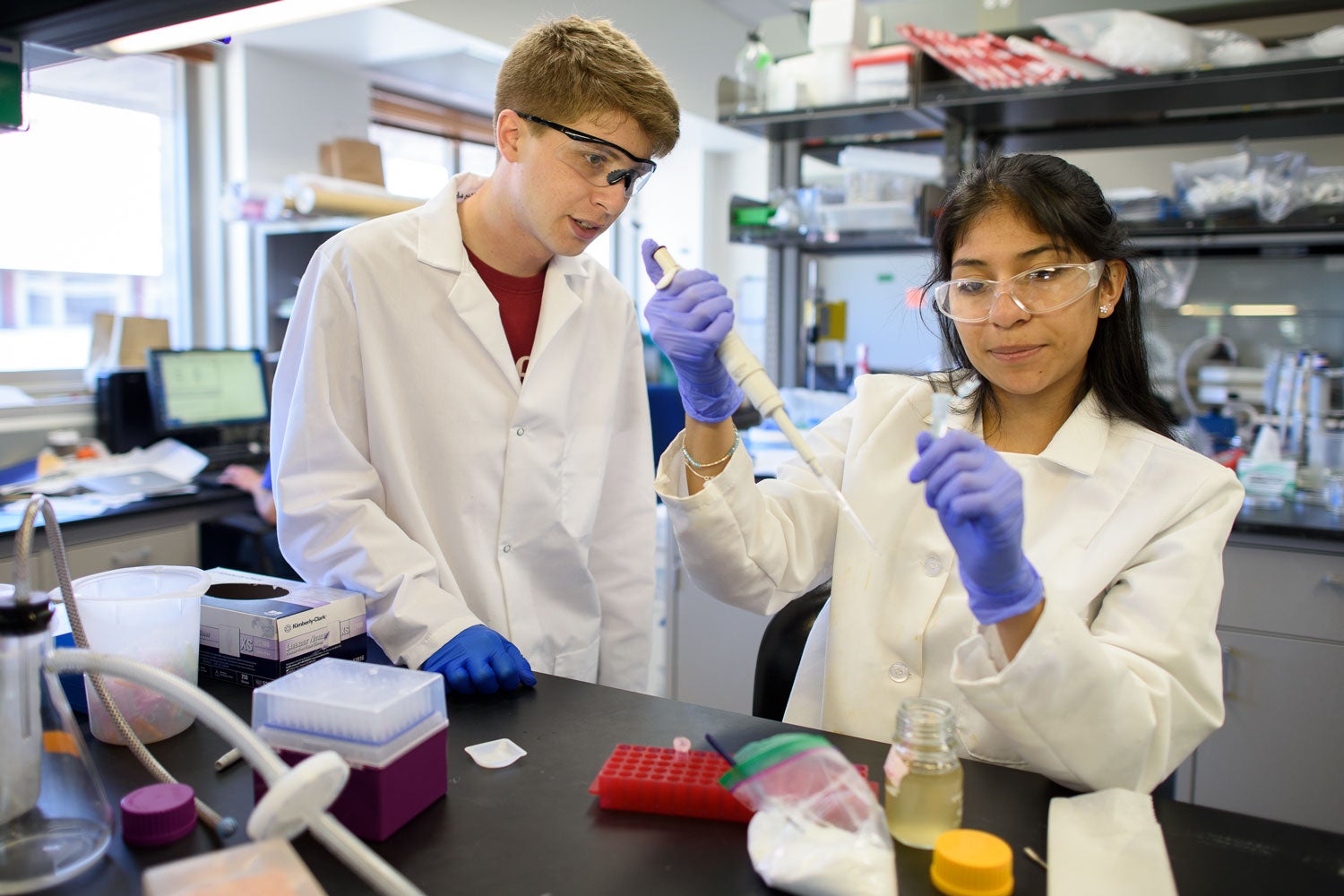Summer programs at Stanford attract students from near and far
During the summer, the Stanford student body includes kids enrolled in sports and computer camps, middle school and high school students – and teachers – enrolled in academic programs, and undergraduate and graduate students from across the country and around the world.
When Blanca Jaime completes her internship at Stanford in August, she will have exactly one week of summer vacation left before she begins her freshman year at the University of California, Merced.

Chris Lindsay, left, a doctoral candidate in materials science, works one-on-one with Blanca Jaime, a high school student enrolled in the RISE (Raising Interest in Science and Engineering) program. (Image credit: L.A. Cicero)
That’s fine by Jaime, who is spending her second consecutive summer working in the Heilshorn Biomaterials Group under the watchful eye of Chris Lindsay, a doctoral candidate in materials science and Jaime’s mentor in the RISE (Raising Interest in Science and Engineering) Summer Internship Program for High School Students.
Like the rest of the RISE interns, Jaime works in a campus lab four days a week – from 9 a.m. to 3 p.m. – and spends one day in group activities, including field trips, presentations by scientists, hands-on science activities and lab tours.
In the Heilshorn Lab, Jaime conducts her own experiments on new materials for 3-D bioprinting – the process of creating biological structures, such as artificial bone, used in medical research. Then she critically analyzes the data using specialized scientific software.
This summer, Jaime was impressed by the capabilities of the rheometer, a lab instrument she was using for the first time.
“I was shocked at all the different things the rheometer could measure, including viscosity, temperature and shear rates,” said Jaime, who hopes to attend medical school after college and is considering a career in pediatric medicine.
Summer academic programs galore
RISE is one of dozens of academic programs for middle school and high school students held on campus during the summer. In addition, Stanford entices middle school and high school teachers back to the classroom with summer fellowships.
During the summer, the student body on the Farm also includes kids attending sports and computer camps, visitors attending conferences, current Stanford students, and visiting undergraduate and graduate students from across the country and around the world.
Stanford Summer Session, the university’s fourth academic quarter, is in full swing, offering a vast array of courses to students – current undergraduate and graduate students, as well as visiting international students. Some of the summer students were nominated by their home universities to attend Stanford’s International Honors Program.
Another Stanford Summer Session program, Stanford 2 to 4 Veteran Accelerator, helps U.S. military veterans enrolled in their first two years of college to further develop the academic skills they will need to thrive at a four-year university.
During the summer, high school students flock to the Farm for programs offered by Stanford Pre-Collegiate Studies, including a sports business academy, institutes focused on the humanities and the arts, a math camp, and the Medical Youth Science Program. The Stanford Artificial Intelligence Laboratory Outreach Summer Program educates high school girls about AI through a combination of lectures, hands-on research projects, field trips and mentoring activities.
Exceptional high school students can become “visiting undergraduates” and earn college credit for courses by enrolling in the Stanford High School Summer College.
The Computer Science Logic Institute, which offers 10-day summer camps for high school students and teachers, tells participants: “Your brain will credit you for studying logic, as it will definitely improve your work in school and your decision-making in life.”
Some members of the summer student body can be identified by their colorful lanyards – baby blue for the musicians and singers taking part in Stanford Jazz Workshop programs.
Others can be identified by the drawstring backpacks that thump against their backs as they walk from residence halls to classrooms – royal blue for the high school students taking part in Intensive Law & Trial: From Evidence to Judgment, and tangerine for the middle school and high school students enrolled in the Great Books Summer Program.
Programs that come with medical scrubs
Stanford Medicine offers several Summer & Youth Programs designed to help high school and undergraduate students prepare for future careers in medicine or research.
During the Stanford Anesthesia Summer Institute, students gain hands-on experience performing procedures in a state-of-the-art simulation lab and observe anesthesiologists providing care to patients. Students accepted into the Stanford Cardiothoracic Surgery Internship program practice key surgical procedures, including knot tying, dissection, suturing, basic and coronary artery bypass suturing.
This is the final week of this summer’s Stanford Medical Youth Science Program, which was designed to encourage high school students from low-income families and underrepresented minority groups to aim for careers in health and medical professions.
During the Stanford Medicine Clinical Summer Internship, a diverse group of nearly three dozen high school and college students got an up-close and personal look at the field of medicine. Throughout the two-week program, students learned the foundations of patient care, including how to administer ultrasounds and injections. They attended lectures and dissected sheep brains and pig hearts. In a visit to Stanford’s Center for Immersive and Simulation-based Learning, they learned how to manage and treat infectious diseases.
The inaugural Advanced Emergency Medicine Program attracted 160 high school students from around the nation. The students, who lived on campus for 10 days, interacted daily with faculty members and learned a variety of skills, including how to suture wounds, perform rescue breaths and chest compressions, and work as a team to stabilize a patient.
“As part of our mission to increase awareness and interest among the underserved, we also supported 10 local students with a full sponsorship,” said Dr. Jason Lowe, clinical assistant professor in the Department of Emergency Medicine. “Overall it was an amazing first year and we look forward to holding it again.”
